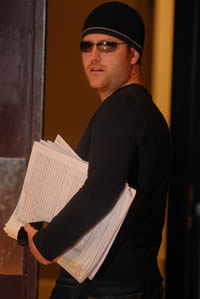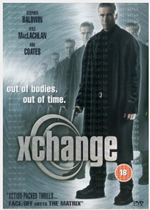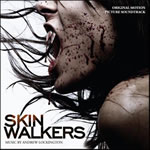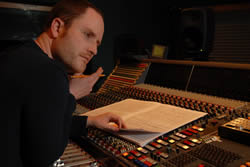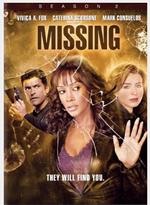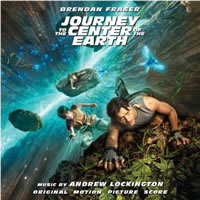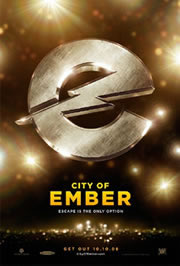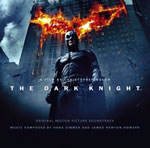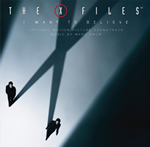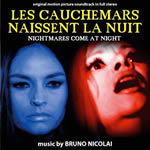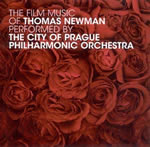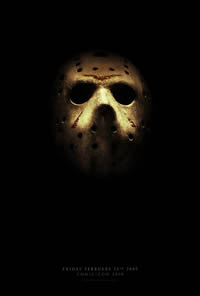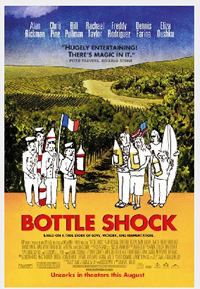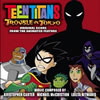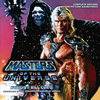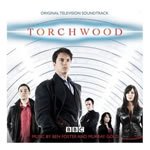 |
Soundtrax: Episode 2008-15
August 2, 2008
By Randall D. LarsonJourney to the Center of the Score
This week we interview Andrew Lockington whose vivid score for the new Journey To The Center of the Earth is plumbing new depths of fantasy-adventure film music. We also discuss his work on SkinWalkers and his latest score, City of Embers. Our reviews this week include The Dark Knight (“through a motific development of rhythm, texture, and a feeling of sound [the score] breeds a fascinating musical psychology”), The X-Files: I Want To Believe (“Snow’s evocative score carries on the mystique of mysterioso and melody that characterized his score for the show’s nine seasons”), The Midnight Meat Train, (“very dark, very synthetic, very layered, and very difficult to listen to apart from the film”), The Mummy: Tomb of the Dragon Emperor (“The score is immediately accessible, as a result, and vividly larger than life in its bold orchestral strokes and thunderous motifs”), Tropic Thunder (“On disc, the score is a powerful modern action-adventure score, unrelated to the sense of comedy that exists only on screen, which makes it especially attractive”), Bruno Nicolai’s score for Jess Franco’s erotic thriller Nightmares Come At Night (“The music, reflecting Franco’s fusion of mystery, eroticism, and suspense, is an intriguing exercise in strangitude, and one of Nicolai’s most unusual scores”), Guy Farley’s The Flock (“an intriguing expressionistic score, one whose motifs are layered throughout an ambiance of morose intensity”), and Silva Screen’s The Film Music of Thomas Newman (“a fine gallery, faithfully and fully realized by these new performances, of some of the composer’s most significant work”).
Andrew Lockington Interview: Andrew Lockington
Canadian film composer Andrew Lockington grew up in the Toronto area, where he took to piano at an early age. “I really enjoyed playing piano, but I hated practicing,” he said. “At 5 years old, if I was asked to learn four lines of a Mozart sonata for my next lesson, I would learn the first three bars and then just make up the rest. But I found out that my piano teacher was on to me – somehow she already knew how that piece went! So she told me that if I played it once it was called improvisation and if I played it the same way twice it was called composing.” Lockington continued to compose, in rock band during high school, and then in an honors composition program at Wilfrid Laurier University. He became involved in film music as an assistant to Mychael Danna, which gave him the experience and credits to launch out on his own. Since then, his film credits have included Lions Gate's SkinWalkers, Samuel Goldwyn's Saint Ralph, Sony Pictures Classics' Touch of Pink, Lions Gate's Cake, and the scores for the HBO features Xchange and Stranger Inside. His early work as either an orchestrator, conductor, or composer's assistant saw him working for such acclaimed directors as Ang Lee, Atom Egoyan, Denzel Washington and Joel Schumacher. In March 2007, Andrew was hired to compose the score for the Warner Bros./NewLine/Walden release Journey to the Center of the Earth, which holds the distinction as the first ever live-action feature film shot entirely using the "Real D" 3-D technology. Lockington’s other recent credits include the Paramount/MTV distributed How She Move and the upcoming Indie feature One Week, written and directed by Michael McGowan. Interviewed while he was prepping to record his new score for the fantasy adventure, City of Ember for director Gil Kenan (Monster House), Lockington discussed his career’s experiences and his approach to scoring significant films on his filmography, including Journey to the Center of the Earth.
Q: How did you connect with Mychael Danna?
Andrew Lockington: After studying music at university, I came to Toronto. This was at the time when the advertising industry was booming, and jingle writing was big business. I tried to get a job as an on-staff composer at some of these jingle houses, and didn’t have any luck, but I did get a lot of overflow work from different houses. I did that for a year, and it was quite lucrative but I didn’t find it as creatively rewarding as I’d expected to. So I decided I was going to pack up and try my hand at film composing even if I had to live off $300 a week and go back to my poor student days – that was what I wanted to do. So I looked into a few options and I decided my best option was just to go around and talk to a bunch of other film composers and find out what they’re doing. As it turned out, the band I was in during high school was a bunch of guys who were ten years older than me, and their previous keyboard player a few generations earlier had been Mychael Danna. So through that connection, and also through my mother knew his mother peripherally, I contacted him and met him as one of the many composers I met with. He was very kind to spend an hour with me and talked to me about the craft. A lot of my background and a lot of the demos I was playing him were orchestral and he thought it would be good for me to head for Los Angeles, because that’s where the majority of the money was for orchestral scores. So I went down to L.A. and I met with a few composers there and I came back to Toronto I decided, well, that’s it, I’m going to move to L.A. Then, literally fifteen minutes after calling all of my jingle contacts and saying I’m moving on, I got a phone call from Mychael, saying that he had a few films and he was looking for an assistant, and was I interested in working with him? So that’s how that began.
Q: How did that apprenticeship and that working education prepare you for launching out on your own?
Andrew Lockington: It was incredible. That was the best education a film composer can get. Film composing is a very unique craft, it’s writing music on a deadline, not only to your taste but to many other peoples’ tastes, and it’s not music on its own, it’s music that combines with visual to create an overall experience. It’s very much in tandem with the visuals, and I think that’s why often film scores don’t stand on their own, because they’re not meant to. They’re meant to be a combined experience. So I learned so much working with Mychael. Initially I did everything from stringing guitars to getting coffee to arranging. I just wanted to be a fly on the wall, because he was doing big films and he was very successful at it, and I very quickly recognized how talented he was. It really opened up my eyes to a lot of other music out there that can influence the film music medium that we’re all in, and he was definitely the pioneer in that. I worked with him, off and on, for about six years. He always allowed me to do my own projects and he co- composed a few projects with me to help me get a credit. Also, the knowledge and experience of travelling all over the world with him recording with the best orchestras and being able to be a part of a film score from the research steps at the very beginning to the recording and mixing and mastering step was invaluable.
Q: What were the challenges and experiences of some of the early films you did, like Xchange, Fast Food High, Touch Of Pink, Saint Ralph?
Andrew Lockington: I’m fortunate to have worked in so many different medium in film, and that’s what makes it really fun and interesting for me. I love being asked to do something I’ve never done before and learn how to problem-solve in a genre I’ve never done before. For example, Xchange was a sci-fi film set in the future and they really wanted me to come up with something representative of the future. It was at a time when electronica was so much our present day that we really couldn’t go more electronic, so I started looking to some of my experience and research and background in world music and trying to pull from all sorts of different areas and try to create a sound that might be indicative of the cultural melting pot that I think we’re headed to in the coming years. Touch Of Pink was a film set in present day but definitely modeled after the 60s romantic comedies but with an East Indian twist, so I was definitely listening to a lot of those scores, the Doris Day/Rock Hudson films, James Garner, and then trying to come up with a version of that that is palatable to the modern audience and also had an East Indian flair to it. It was a lot of fun to do.
Q: SkinWalkers brought you some attention, since it was also released as a soundtrack. What was your approach to a modern horror film such as this, which retained an orchestral melodic sense without going into a bunch of weird sounds.
Andrew Lockington: When I met with Jim Isaac, the director, and Dennis Berardi, one of the producers, I realized they were telling a really great story. It was not a gore flick, it was a movie about real people and putting them in this situation that’s just unfathomable for your average person, and really setting up a real life, normal town that is suddenly faced with realizing that werewolves are real and they’re living within the town. The story really dealt with good and bad, but a lot was this grey area that people who feel they’re morally right often make choices that aren’t morally right, so there was so much symbolism that we could really reflect in the music. The music could really help tell the story, and I love to be able to write a score that is thematic and parallels the film and can really tie elements together subconsciously for the viewer. And, also, this is a film that was sort of set anywhere/anytime USA, they worked really hard to not have a lot of technology in the film, the pickup trucks could have been any vintage, they would have been from any time, so the connection, it has a real organic feel to the music, and I’m calling for a score that didn’t have a lot of electronics, but it was all these natural instruments which was really fun to have that limitation and find a unique way to approach it.
Q: What kind of music nowadays does a scary movie require?
Andrew Lockington: I was immediately reminded of research I’d done when I worked with Mychael on African music, and I remember going to the University of Toronto and sitting with a professor there, Russell Hartenberger, who’s a bit of an expert on indigenous African music. I listened to these recordings that he had made in the field that, from a Western musical theory standpoint, my brain could not wrap around. I could not figure out where the downbeat was – my brain would almost figure it out for a bar or two, and then I’d lose it. And it almost made me nauseous, because my brain was working so hard to figure it out. But there was a definite natural rhythm that I don’t think we’re very familiar with in North America. So that was something I immediately thought of – how can I get some sort of tribal element that still feels natural, and yet it can’t be decoded by our musical ear and our tapping foot, and that’s what I came up with. I was lucky, there was a fantastic master drummer from Ghanna who was teaching at a Canadian university, and I managed to get in touch with him, and he put together a group of drummers from his native Ghanna who were all here, either touring or teaching, and I recorded them here in Toronto and came up with these amazing rhythms. Some of these rhythms are just hundreds and thousands of years old, and just started working from that standpoint. I did that very early on and I did that before I wrote any themes or did any orchestra work, and I created this grid of drumming that in Logic and Protools I then developed this crazy tempo map. When you look at it, it just looks like random beats and downbeats, but when you listen to it, it makes sense. I wrote all the orchestra stuff to that and we recorded the orchestra to that, so the tempos are not consistent and the downbeats are sometimes artificial. I didn’t know what kind of challenge it would be to the orchestra, but it was such a natural movement, once they got in the groove, they just played perfectly. Even though it’s something that’s so foreign to our North American and Western culture and musical training, it’s something that is very natural to the human body.
Q: And it almost subliminally sets the listener off a bit; they don’t know quite what it is about the music but it’s different and so they’re a little bit on edge, which is perfect for a film like this.
Andrew Lockington: It’s one of those forays in film score writing where you’re on to something and you have no idea how it will turn out! But one thing I did, though, because there aren’t a lot of low drums in his ensemble, there are a lot more talking drums, the upper-mid, low-mid range, and I really wanted to include low drums. So I had also done some work with Kodo, the famous Japanese Taiko ensemble, on a previous film and I remembered those really big, low, hollowed-out log drums, and was able to use some of them on SkinWalkers as well. I studied these old Japanese rhythms that are less hard to decode but filled with so much fluidity in the tempos and in the movements, and yet it’s all very natural. So the SkinWalkers score is really a combination of those two influences which, I guess in an earlier time, I felt it would be wrong to combine the two, but it just seemed appropriate to draw on those two areas for the film.
Q: What was the earlier film you worked with Kodo on?
Andrew Lockington: It was Ang Lee’s version of The Hulk, when I was working with Mychael Danna. That was my last film with him. I had worked on my own for a little while, and he called and asked if I would come back and help him with that. We had recorded Kodo for that.
Q: Too bad nobody got to hear it…
Andrew Lockington: It is too bad. It was a really great score. Mychael’s done a great job on all his scores, and that was no exception. I think one of Mychael’s themes survives and can be heard in the finished score now. But I’ve never actually heard Danny Elfman’s version. I had my fill of that film when I was working on it with Mychael!
Q: Just prior to SkinWalkers you got involved with a TV series called 1-800-Missing. What was that experience like for you?
Andrew Lockington: Yes, unfortunately the name got changed for the second and third season to just Missing, but we all liked to refer it and have selective memory of the 1-800- part. But it was a great experience. It was right after The Hulk, I had come back to Toronto and had expected to see that film through with Mychael, so I got a call from head of music at Lionsgate, who was a friend of mine and I had met him on Xchange and a couple of other projects, and he said “We’ve got this TV show, would you like to step in and do a couple of episodes for us? We’re just trying to figure out the composer situation, and it’s immediate, and do you want to step in and take a shot at it for a couple of weeks?” I’d always thought I would just to stick in film and stay away from television, but I realized it’s a great medium to write in. I learned an immense amount. It was a high quality show with great storylines, and it was a great experience. I hadn’t expected that. Another great thing was that the producers and the network were really good to me about letting me try new things, and try strange instruments and try new approaches. They gave me a lot of freedom and it allowed me to really continue my education on unique instruments and unique approaches to writing, as opposed to just doing a synthesizer score. I was bringing in four or five live players a week, and doing really fun, interesting things with the score.
Q: Stepping into a series that already had an established musical design or format, were you restricted to that or did they say “go ahead and make it your own now?”
Andrew Lockington: There had been another composer on the series prior, and I was stepping in to episode 8. I don’t know the details of why that composer left the series, he might have been moving on to another project, I’m not sure. But they had said to me “do you want to have a listen to the other music? We’re not quite sure if that’s the direction we want to take.” I said, “well, if you’re not sure, I won’t listen to it, and just let me do my own take and see where we’re at.” So I was very fortunate to be in that position, because I had worked with some of them before they trusted me, and I was able to just approach it as a blank canvas and I didn’t have to try to evolve from where the music had been and to where I wanted it to go.
Q: How did the scoring approach evolve from where it started when you came on?
Andrew Lockington: I had themes that recurred that were usually tied into characters and personal situations, but because every episode was about a very different case and very different situations, they were almost like mini films. Every third or fourth episode you’d have a little bit more progress on a love interest between two characters, and that called for recalling a theme that we heard before, but many of the episodes were almost like little self-contained movies, where themes would exist within the show and wouldn’t come back in another show. The main character would have these visions, and these visions would offer clues that would help her solve the case. But they would offer clues to the audience as well, as to who the victim was or who the assailant was, and so musically each of those visions I was trying to incorporate a theme that would parallel that discovery, and ultimately as the mystery unfolds, that theme would unravel and become more clear in scoring the reality at the end of the show. So it was fun and actually it was a great exercise in themes and finding different ways to vary themes and evolve them throughout a show, which is something I try really hard to do in my film writing.
Q: Another film you did after that, that seemed to give you some good opportunities in urban music, was How She Move.
Andrew Lockington: Yeah. I’ll have to say I did How She Move twice. I did a version of the film which was at Sundance, and when the film sold at Sundance, it was bought by Paramount Vantage and MTV and they did some additional reshooting and restructuring of the story, so I went in and rerecorded about a third of the score. I came about that film because I had done Touch Of Pink with director Ian Rashid, and How She Move was his next film. And when I worked with Mychael, he and I co-composed a movie called Stranger Inside, for HBO, so I had some experience in that urban and dark world that I could then touch on in How She Move. It was an amazing exploration, because ultimately we were faced with a Chinese finger trap, where we’re basically trying to write a score that is hip hop. Everyone said “we want the score to be hip hop, we want it to fit with the songs. But we want it to be instrumental.”
Well, really hip hop music, I learned, borrows from everything. Hip hop music is a mélange of every other style of music, and you’ll have a hip hop song that has a pentatonic scale or an Asian theme to it, or it’ll have a Brazilian feel to it, and you take away the hip hop lyrics and you have a Brazilian cue. I even went so far as to hire a hip hop singer to come in and sing on some cues and we very quickly realized, “well, I’m just doing source music.” So the approach that I had with Ian, when it was a Sundance film, was to really almost make it more soulful. We hired a Canadian singer, Kellylee Evans,
she won the Thelonius Monk award for singing and ended up doing a concert at the Museum of Civilization. She’s an amazing singer and she came in and just did these vocalizations over a lot of my score, and we just had this great dirty guitar feel to it, and it just felt very real and very internal, as opposed to the sort of external nature of a lot of hip hop music. Hip hop was being used in the film as source music, so it was nice to have something that really got into the characters. The approach when Paramount bought it was to go in and sort of take out the elements that felt a little bit too much like soul music and come up with something that felt more like a hip hop score. So we were again faced with that challenge of what a hip hop score was. Ultimately it came to adding strings to a lot of the themes that I had done before. It was a 22-string section, just 4-part chord movements and theme motifs, but it really worked. Somehow it felt justified in the company of all the source music. And I ultimately attribute that to the fact that, working in films, especially in our Western culture, strings and orchestra are just an accepted musical medium in film. People don’t ever say “well, how is that justified?” because it’s just such a staple in our medium that it works and people relate to it. People can listen to the music and hear through it, as opposed to hearing the instruments that are playing it.
Q: Now coming into Journey To The Center Of The Earth, how did you prepare yourself for this large form orchestral score?
Andrew Lockington: I have to say this is the kind of score when I heard Raiders Of The Lost Ark or E.T. or Star Wars, those were the scores that told me I wanted to become a film composer. So when this opportunity came up it was quite funny, because none of my other films had taken me in this direction, and here I had an opportunity to score a film from the perspective of a six-year-old boy. And I’ve got to say, working on this film for a good six months, I felt like a six-year-old boy the whole time! It was such a fun film, and because of the nature of the film and the direction I was given and the music the film was calling for I was able to dive into that more retro world of 20 years ago, the strong themes and adventure. The movie, although it has a couple of hard emotional moments, is a ride. It doesn’t need to bear the weight on its shoulders of what a lot of films do these days, they’re much more serious subject matter and there’s much more responsibility. Which is a good thing, but it was fun not to have to worry about any of that and just see the film as if I was a kid.
Q: Obviously anyone who’s familiar with film music is aware that Bernard Herrmann had written one of his classic scores to the 1959 version of that story. Was there any need to divorce yourself from that and make sure you didn’t go in that direction, or was that even an issue for you in this film?
Andrew Lockington: I made a conscious effort to not watch that film. I had seen it years and years ago, but I didn’t think about watching it again. I knew very early on, and the director explained to me very early on, this is not a remake. This is a unique take and we’re doing something different, and that really absolved me from the decision of how to I pay homage or do I need to pay homage to that. And it was great that we had a different film, because we’re not trying to redo something better than people feel it’s already been done. So the first thing I did after I got hired, I went on eBay and I bought an original 1st edition copy of the book, which was incredibly affordable, probably because the movie hadn’t come out. I exercised my 20-year old French education and bought the French edition of the book and really read through it and studied the pictures and really tried to get in the head of how people would have reacted to this 150 years ago when it came out and it was just so groundbreaking. Because I realized early on that the technology that we were dealing with on this film was equally as groundbreaking in our present day, so I really wanted to capture the awe and the feel of the book. I also wanted the film to have a sense of ancestry to the music, in some ways. A lot of people have related the score to the films in the 1980s that have the big powerful themes, but that came about because I was trying to find a string theme that would encapsulate the awe of this journey, and not only this journey but the birth of science fiction, really, with Jules Verne.
Q: Would you describe your thematic approach to the score and how you integrated the themes even in the midst of moments of very bombastic action?
Andrew Lockington: It was a challenge to write the main theme. While the film as a whole is like the adventure films I grew up with, the medium of filmmaking is very different than it was then. I think probably our audiences aren’t as patient as they were twenty years ago, so sequences happen much quicker, they’re much shorter, and there just isn’t the opportunity for long themes any more between action moments, especially in this film, it’s a thrill ride. It’s like a roller coaster ride and if you’re going down a hill and you’re gaining speed to do a loop-to-loop or go around a corner you’re always accelerating toward the next moment. So looking at the film from a practical point of view, I had to look for opportunities where I could establish my theme in the first third of the film, where it could be in the foreground, and how much recognition I could get from the audience playing this theme behind dialog or within action and so forth. I found what it really required was a 4-bar theme that can modulate into different keys and has variations, but if you hear that 4-bars you know the theme and it’s served its purpose. And then within that, I went and I found all of these moments that are shorter than that 4-bar sequence, and I realized that this theme had to have a rhythmic hook, even in the first bar, that if I can only play four notes, it’ll be a motif that harkens back to what that main theme is, and will have a similar effect in reminding people and getting it in their subconscious. So the structure of the main theme came about very much because of the nature of the film. Because it’s simple, I was able to put it in more complex orchestrations and do things with the music and behind it that were really tailored to the scene. It allowed me to nestle this theme within it, and ultimately I think I have 150 variations of the one theme! But it worked very well for this film, and it’s a good example of how an approach can change based on the material you’re given to work with.
Q: In Journey, you’ve once again brought in a renowned drumming ensemble, the Kiyoshi Nagata. How have you integrated that textural element into the score?
Andrew Lockington: A very different approach than SkinWalkers. It’s actually the same ensemble I used on SkinWalkers. I brought them in during the latter part of writing, because I realized as I was writing for this orchestral percussion that I wanted some really low drumming and some hits on the side of these big wooden drums that I’d fallen in love with working on SkinWalkers. I just wanted some sort of element of that in the Journey score. Unlike SkinWalkers, Journey was written for orchestra and I brought those drums in simply as a sound, so they’re played fully within a regular Western musical structure. The sounds are employed with the orchestra, and I think it’s effective. Another thing I was able to add to it was this analog synthesizer programmer that I used who came up with these really interesting sounds that don’t sound digital – they’re not digital, they’re just basically electricity through resistors and circuits and pots. That kind of sound seemed to really work with the orchestra. When I mentioned it to Eric Brevig, the director, he got scared and said, “no no, there’s no electronics, there’s nothing like that!” and yet when I played it for him with the orchestra samples, he said “wow that sounds great, I don’t feel like I’m listening to anything other than music.” So those two elements kind of allowed me to have a little bit of fun within the medium of an orchestral adventure score.
Q: Did the 3D aspect of the film affect what you were writing?
Andrew Lockington: It was funny, there was a big joke when I was doing it, from friends and colleagues, who would say, “wow, you’re writing a 3D score, that’s totally different!” and we’d all laugh. And it is different. I proved myself wrong. I would actually work to a two dimensional picture. We all, actually, worked to the left eye version of the film, even the edit crew would work to the left eye version, and at the end of the day we had a whole other edit suite that was devoted to editing the right eye version of the film, and matching it to the left eye. The editor and the director, more than me, were continually going to a 3-D screening room and watching what they’d done in 3-D. I flew down to L.A. and sat in this screening room to watch the 3-D version and immediately realized, “hey this is not the 3-D technology that I thought 3-D technology was. This is a completely different ball game.” It’s actually a shame that it’s even called 3-D, because I think people think that it’s like those old films from the ‘50s, and it’s so different. It just wakes up a part of your brain that’s never been woken up by a film before, and you basically, it’s not watching a film it’s being in a film. How it affected the music was, there were scenes that basically came alive and had elements within them that either the main character you were getting much more personality or much more communication from their facial expressions or in the background there were actual physical landmark elements or characters in the background who in 3-D really called for more musical recognition. Many times I would and watch it in 3-D with my score and come back and make changes to what I had done.
Q: You’re now working on City of Ember. How far into that score are you?
Andrew Lockington: I’m pretty close on crunch time. So this is a great procrastination, talking to you! I go to London in ten days and we’re recording and mixing at Abbey Road.
Q: It seems to be a lavish, futuristic kind of adventure film. How would you describe the music needs and what you’re providing for this film?
Andrew Lockington: It’s very different than Journey, as far as the musical needs. There’s less dialog in City Of Ember, and there’s so many moments where Gil Kenan, the director, does an amazing job of telling the story in visual ways, and really leaving opportunities for music to finish the experience. The movie really responds well to music and themes and to the evolution of the story through the music to the end of the film. l can have conversations with the director and producers about themes, and I can say “we need to hear this theme at the end of the film, the audience needs to have a relationship with that theme, so let’s hint at it in these places,” and those are really fun discussions for a composer to have and be able to have a bit of a think tank with no ego’s involved, and all work together to make something that’s bigger than the sum of its parts.
Q: One of the responsibilities in a film like this, perhaps even more so than Journey which at least takes place on the real earth, is to bring the alien environment of the City of Ember into reality for the audience.
Andrew Lockington: That’s true. It sort of harkens back to humanity, really, because you’ve got this society that exists without any history except for its own brief history. Beyond its own brief history it has no idea of any of the other world events or musical styles or evolution of music, or social things that have led to them being there, so it’s interesting. I was doing an interview on a sci-fi film and somebody said, “all of these weird sounds that you can use, can we just get weirder and weirder as sci-fi films get different and we’re experiencing new things? Are we going to run out of sounds?” I kind of feel that so much of those things are the human reaction to those things, as opposed to scoring really strange metal shape. Certainly that influences how you score it, but usually you’re also scoring how the main character is reacting to that experience, so I think there’s always a certain level of humanity within a film and within the themes in the score, and that’s sort of been one of the things I’ve been falling back to and really trying to extract from City Of Ember.
Q: No matter how far out you get visually or conceptually, at its basic level a film is about people, and you don’t want to get too far removed from that. I think your affinity toward doing that throughout the films we’ve been talking about is really very interesting. You’ve captured that element that’s needed in film scoring quite well.
Andrew Lockington: Thanks, I appreciate your saying that. It’s an ongoing process and learning experience, and it’s a much finer line to walk these days that it used to be. I like having films that give me an opportunity to elicit an emotional response in an audience or even heighten the emotional response that they’re having to the picture. We all are careful not to feed an emotional response to an audience on a platter, but I like to think of really good film music as MSG, and it just makes the flavors taste better and stronger. In particular, your emotional reaction to something can be much stronger. Music heightens your emotional response. Whether your emotional response is sadness or grief or happiness, a really good music cue can take that individual’s experience and augment it.
For more information on Andrew Lockington, see his web page at www.andrewlockington.com
My review of the Journey to the Center of the Earth soundtrack appears in the July 3rd column; my review of the SkinWalkers soundtrack appears in the August 13, 2007 column.
New Soundtrax in Review
Hans Zimmer and James Newton Howard’s revisitation to the new incarnation of Batman, helmed by Christopher Nolan, has taken wing from Warner Bros Records. The Dark Knight develops the motific rhythms and texture introduced by the composers in Batman Begins and carries them into darker territory. As such, it’s an uneven album on disc, as a lot of tracks that were effective in carrying their weight in their film context don’t work as well away from the film on the album (the nine-minute opener, “Why So Serious?” is a difficult listen, comprised of awkward moments of severe noise, found sound, near silence, and industrial riffing; similarly “A Little Push” is discomforting dark environment). On first listen I found some of these tracks very tedious, but upon further listening and reflection, I began to recognize how perfectly they fit the film and what it was doing. Zimmer’s chaotic music is perfect to delineate the twisted and perverse mind of The Joker (beautifully realized by Heath Ledger that would have been a career defining performance even if it wasn’t his last role). This is perhaps most fully realized in “Agent of Chaos” in which Joker’s well-planned crime spree spirals into an ascending wave of relentless criminal brilliance just as it is spiraling inexorably out of control through circular waves of strings, unyielding percussion, small filigrees of tuneful piano, low growling violin figures (which sound almost like they could have come out of Armstrong’s Incredible Hulk) and finally a climbing siren of single-minded sound that reaches higher and higher levels of self-confident obsession as Joker’s fiendish plan is carried out with horrible results. The cue ends with a poignant piano rendering of a motif that will become associated with Harvey Dent’s incarnation as Two Face.
The composer’s Batman motif similarly carries with it a subversive psychology well fitting to the story Nolan is telling visually. A close listen to what the music is doing will reveal its purpose. The score, as much as the film, is a journey into darkness, tracing the Batman’s passage from disrespected hero to misunderstood villain, and only a few characters – and the audience – know how it really played out. The score brilliantly captures the duality of the character – Batman’s own incarnation as Two Face: the hero as recognized hero, and the hero as hated lawbreaker, willingly accepting that role for the better good. The film is Bruce Wayne’s journey, as was Batman Begins; but where the latter showed him emerging from darkness of depression into the light of heroism as Batman, The Dark Knight takes a kind of reverse excursion, from wholesome hero to tainted champion, doing the right thing but taking the fall while doing it. The score’s main motif is a rhythm based riff, carried over from Batman Begins but given a somewhat corroded aspect. It’s not as optimistically heroic; this Batman is mired in dissolution and disconsolation. It’s not even a theme, as such, since there is no recognizable melody; the composers provide a two-note rhythm pad that develops progressively through orchestration, tempo, and intensity. While the motif lacks the melodic flavor or musical interest of Danny Elfman’s theme from Batman or Elliot Goldenthal’s from Batman Forever, the Zimmer/Howard motif is nonetheless highly effective at casting the hero in very dark shades of grey and building a progressive heroic stature through rhythmic development. “Like a Dog Chasing Cars” proffers an iconic treatment of the motif, rising into a proud and stimulating intonation of horns, representing the inner heroism and self-awareness of the Batman, while the quickly-bowed strings provide a constant reflection of the obsessive and fearless drive that keeps him going. “Introduce a Little Anarchy” establishes a neat interaction of the Batman and Joker motifs and builds on a provocative communication of the two musical ideas.
While Zimmer’s influence is most strongly felt on the Joker and Batman material, Howard’s expertise brings a mixture of terrible poignancy and unfortunate fall from grace of the Harvey Dent character. “Harvey Two Face”, which is sequenced as track 3 even though the events occur in the third half of the film, is a splendid mixture of tragic passion, sorrow, and ultimate madness, echoing the transformation that occurs to Harvey Dent in the picture. The cue culminates in the score’s most prominent melodic writing, a beautifully poignant melody sensitively portrayed by strings, growing into a powerful ascending melody for violins echoed by horns, and an affecting portrayal of insanity borne out of great tragedy.
The concluding track, “A Dark Knight,” is at 16 minutes a tad overindulgent; it continues with little variation for an extended end credit crawl. It’s appropriately morose and ironic as a summation of all that’s gone before, and even in its lack of variance it speaks volumes – Batman’s resolute acquiesance of his new role as the Dark Knight, accepting the mantel of a villain in order to achieve the proper good is well reflected in its adamant redundancy. This is now the way it is, and the way it must remain.
In a final analysis, the score for The Dark Knight is a musical study in dualities. Each of the three motifs has two sides: Batman the Good, Batman the Dark Knight; Joker the Brilliant Strategist, Joker the Madman; Harvey Dent, Gotham’s incorruptible icon of law and order, Harvey Dent, Two-Face, disfigured and disgruntled terrorist. Zimmer and Howard provide a brilliant thematic accompaniment to these ideas, not so much through melodic themes (although partly that in Howard’s case) but through a motific development of rhythm, texture, and a feeling of sound that breeds a fascinating musical psychology.
For more information on the Dark Knight score, see Rudy Koppl’s interview with both composers, posted at www.musicfromthemovies.com Mike Brennan’s interview with Zimmer and Howard, posted at www.soundtrack.net is also a recommended read. Tracksounds has also done an interview, available at www.tracksounds.com
Decca Records has released Mark Snow’s new visitation to The X-Files: I Want To Believe. The new score follows in the footsteps of the television series and the first X-Files movie, Fight the Future, although the film does not revisit the ongoing mythology from the first film but rather sets the characters of FBI Special Agents Mulder and Scully in a new, standalone supernatural adventure very much like one of the series’ standalone TV episodes. Snow’s evocative score carries on the mystique of mysterioso and melody that characterized his score for the show’s nine seasons, expanded, as with Fight the Future, into the larger dynamic of the big screen. Unusually, the majority of this score, at least on disc, comprises not the brooding mysteriosos and spooky atmospheres than Snow has been so good at on TV, but the more melodic and passionate material that reorients the story towards the characters and their perspective. The score opens with “Moonrise,” a dark and furtive evocation of rising danger, of darkness revealed, moanings horns over strident drum beats and a jangling, pulsing texture of growing synths. A very spooky opening that segues into a frantic riff for strings and brass that really gets the orchestra – and the listener – moving. A finality of resolute drumming ceases the pursuit, and a lonely notation from harp culminates the cue very quietly. “No Cures – Looking for Fox” starts out with a quiet piano motif amid hushed choir and strings, but soon sets off at a fast pace for harp over synth drumming and more of the choir. The score comes to life, melodically, in the compelling “The Trip to DC,” where Snow whips it up into a persuasive melodic cadence, growing in intensity and beauty with a poignant piano melody over the and nest of active strings. “Father Joe,” which follows, carries on the former’s melodic wonder, with voice added to give a very nice tonality to an otherwise predominantly synth vibe. “What If Your Wrong” carries a nice texture with a sonarlike percussive pulse that gives the slow and warm string cue a muted urgency. “Ybara The Strange” is a very warm melody for piano and strings. “A Higher Conscious” contains some very nice harp playing, very provocative and texturally interesting in the midst of a reflective, atmospheric cue, while “The Surgery” contains some of Snow’s finest and most poignant violin writing, intoned over a high female choir and vocal soloist; by far the score’s most moving musical composition. It humanizes the events of the story and characterizes the essence of The X-Files as being a story about people and their interactions – reflecting here a very warm, positive, and humanitarian aspect, while much of the rest of the score in its darker moments is dealing with less favorable interactions. “March And Dig” proffers the first (of two) very subtle references Snow will make to his original X-Files TV theme; it melody is played very slowly and deliberately by strings, evoking a mysterious atmosphere pregnant with discovery and revelation. “Foot Chase” is a very provocative action cue with tom toms stirring up a frenzies concoction of strings and synths that enliven and the action of the foot pursuit to its conclusion. Interesting textural elements are inserted into the musical depth to give it a heightened degree of musical interest as it progresses. “Tranquilized” also contains some very unusual textures, with a wailing train horn sonority from brass resonating amidst a pulsation of drums and horns and a burbling pad of synths, an effective musical delineation of an altered consciousness. “Home Again” provides the film’s conclusion with a very poignant and warmly reassuring denouement, ending on a final musical suggestion of the familiar X-Files TV theme (it’s only real presence in this score).
The album includes with a remix of the X-File's TV theme song by rap star, UNKLE, which is actually quite eloquent and not your typical dance/hip-hip remix, starting out with a very compelling acoustic rendition of the theme featuring very pronounced violin over the familiar piano arpeggios before emerging into a rock rhythm, and then returning to the prior acoustic treatment. Concluding the CD are a pair of songs, a rock tune called “Broken” from UNKLE, and a new track, “Dying 2 Live” from rap star Xzibit, which is best left unlistened to unless you have a tolerance for rap.
For more information on Mark Snow’s X-Files score, see my interview in the May 23rd column.
The score to The Midnight Meat Train Robert Williamson and Johannes Kobilke, released by Lakeshore along with a songtrack album of the films rock and roll tunage, is just about what you’d want the music to be from a film with that title, based on a visceral horror story by Clive Barker. It’s very dark, very synthetic, very layered, and very difficult to listen to apart from the film. Very much in the school of atonal sound design and disturbing ambiance, it sounds as if it will be incredibly effective at maintaining a mood of unease and scary/spooky in the film, which opens August 1st in limited theaters and Directed by Japanese cult favorite Ryuhei Kitamura (Versus, Azumi, Godzilla: Final Wars), the film is based on Barker’s short story about a New York photographer who takes it upon himself to hunt down a subway serial killer. The score establishes and introduces a claustrophobic atmosphere of relentless oppression and agitation through all manner of layered sonic impressions. The music doesn’t so much wallow in darkness as exuberantly manifest a darkness of its own that envelops the listener fully. The composers, Kobilke has been a veteran of German film music since 1996, Williamson is relatively new to Hollywood film music, craft an effectively shuddery industrial tonality that on its own becomes quite frightening to hear; I can just imagine how frightening it will be with Kitamura’s visuals. The textures are rather interesting and inventive, albeit embedded with an exceedingly dark and often nonmelodic or even nonmusical grain. “Leon and Maya” and “Engaged To Be Engaged” do proffer a bit of melancholic melody and warmth in the midst of Barker’s primal chaos, and there’s a persuasive acoustic piano motif evident in the midst of “Guardian Angel,” but the predominant flavor of the score is one of grinding tonality, sonic metal shavings, and raucous clamor that doesn’t make for an especially pleasant listen on its own.
Randy Edelman’s score for The Mummy: Tomb of the Dragon Emperor, released this week by Varese Sarabande, is as much of a massive fantasy-action score as it needs to be. Edelman has maintained a fruitful collaboration with directed by Rob Cohen (Dragon: The Bruce Lee Story, Daylight, Dragonheart, The Skulls, xXx) and this new score carries on that vibrant tradition. The composer’s affinity for accessible melodies is well in evidence in this score, as is his penchant for exotic and interesting orchestration. All manner of Chinese and Middle Eastern instruments have a part in this score (the low sonority of an 8-foot Tibetan Horn resonates mightily behind the orchestra and choir in “Crash and Burn” and elsewhere; the er-hu, Chinese violin, is beautifully offset against the orchestra in “Open Wound,” “Ancient China,” and “Return of the Dragon;” ethnic voice in “Reading the Scrolls;” an ensemble of multiple Chinese instruments on “New Year’s Betrayal”); there’s also an air of respectable British anglophilia in a few places (“Memories, Retirement, and Dinner,” “Love in the Himalayas”), but all of this is wrapped up wrapped up in a splendid and old-fashioned styled main theme, very Indiana Jones-ish yet marinated with Edelman’s own eloquent sense of style and melody (I suppose even the main theme seems to suggest a bit of old Britannia). The picture, of course, has plenty of huge, spectacular action sequences, and these are well enhanced by Edelman’s finely carved epic orchestral compositions. But the score’s central element remains the majestic main theme, an complicated eight-note melody that ascends and descends the multilayered roofs of a Chinese temple, reprised throughout the score to reflect the once and now again glory of the Dragon Emperor, whose regained rise to power (not to mention, life) is the crux of this film’s journey into mummydom. The melody line sounds old-fashioned perhaps because it eschews any of the current vogue of rhythm-based action scores (see Dark Knight, above), not that I think there is anything wrong with that style, but at the same time there’s something truly refreshing about a new score that isn’t afraid to embrace melody for all that melody can do in a score like this. Edelman and melody have been lovers for many years now, and Tomb of the Dragon Emperor is a rich widescreen tapestry upon which Edelman continues to flaunt his unabashed fondness for maid melody. The score is immediately accessible, as a result, and vividly larger than life in its bold orchestral strokes and thunderous motifs. The score may not necessarily be psychologically complex or subliminally interactive, but this film doesn’t plumb those depths anyway; it called for a fun, adventurous, spectacular musical score and Edelman supplies that beautifully. Throughout the development of the score, through its epic action pieces and its softer interludes, Edelman unwraps the theme and sets it free; it surges to life with all the vitality of a resurrected mummy, announcing its own glory to the greater world; in “Rick and Evy in Battle” the main theme soars above the battling orchestral clash below, resonating proudly to recognize the rhythmic dissonance from which it has emerged. “The Reign of Terror” is a bravura track that incorporates most of the score’s diverse elements – the glorious main theme for raging, bold brass and then passionately for full string section, the vicious percussive battle music, the subtle textures of er-hu, yangqin, and guzheng. The score is also enriched by quieter moments, notably a beautifully love theme performed by Edelman on piano with orchestra (“A Family Presses Close,” “A Warm Rooftop,” and the second half of “Love In The Himalayas;” the theme is also played orchestrally in “Alex and Lin”). “Silently Yearning for Centuries” captures a grand sense of unawakened passion through a reflective motif developed by strings and progressing into a proud resolution from proud horns. “Shanghai Chase” includes a very amusing moment with a quirky organ taking the rhythmic melody line for a couple of bars.
With two hours of music in a 121-minute movie, Tomb of the Dragon Emperor defines the term “wall-to-wall” music. Varese has culled a generous 1:16 minutes of score for the 30-track soundtrack, which includes a closing lounge song by Helen Feng in wondrous 1940s vintage jazz style.
For more information on the score, see Scott Essman’s interview with Edelman in the current online issue of Film Score Monthly.
(Noted by imdb and Wikipedia: John Debney is credited with providing additional rescored material for some of the bigger action sequences. Not an unusual practice in current cinema any more than it was in the 1930s and 40s. But the score is clearly Edelman’s own).
Theodore Shapiro’s score for the new comedy, Tropic Thunder, which comes out on iTunes and on CD via Lakeshore Records August 5 (they’re also releasing a separate CD of the songs heard in the movie), is a fine action score that plays it straight behind the film’s comedy, which is about a group of self-absorbed actors who set out to make the biggest war film ever in the jungles of Southeast Asia but inadvertently encounter real bad guys. Ben Stiller, Robert Downey Jr., Jack Black, Brandon T. Jackson, and Jay Baruchel star. The score opens with a lavish, exotic, and vibrant overture for orchestra, heavy percussion, ethnic voicings
, and a splendid adventure theme for brass that gives way to a soothing romantic melody from strings punctuated by low cellos. Gives every indication of this being a huge action fest unequalled in screen spectacle – but of course we know better. The score plays straight man to the film’s comic absurdity, which of course only makes the comedy funnier in the film. On disc, the score is a powerful modern action-adventure score, unrelated to the sense of comedy that exists only on screen, which makes it especially attractive. Performed by a large orchestra, the score is rich in detail, texture, and melodic power and passion. An exotic percussion adds depth to the orchestration, with gongs, hand drums, and other effective things to be hit. “Four Leaf’s Plan” is a very compelling atmospheric track resonating behind dialog; furtive glidings of strings embellished by moaning synth, gongs, shakers, and squeaking flutes, opens into an active array of propulsive strings. “Enter the Dragons” is a rhythmic cue with some very nice percussion textures that expand the cue into a tremendous sense of forward motion. Action cues like “Bad Feeling About This,” “Panda Attack,” “Don’t Judge Me,” and the second half of “The Golden Triangle” are brimming with fast-pace percussion-driven rhythms, embellished by ethnic flutes, staccato-like violin riffing, and synthed textures; “Shadow Me, Pinocchio” is hard driving rock and roll, blistering electric guitars and shrapnelled bits of strings and hand drums. Shapiro’s action material is very good although it grows a bit tiresome on CD after so much of it without variance. “Flamethrower,” however, is a furious action track for strings and slamming percussion with a shredding metal guitar riff, but at 1:30 it opens into a very interesting charge full of strings, synth-drums, massed horns, low tom-toms, and a high-end vibrato voice that gives it a unique and very appealing texture. “The Wet Offensive” is a nicely textured moody atmosphere for ethnic voice over a reverberated synth tonality and vibrato violins; builds a very nice atmosphere. Shapiro’s main theme emerges out of the embers of “Blow the Bridge” in a nice arrangement for strings punctuated by percussion. The album’s final three cues accompany two mock-trailers of the characters’ movies – “Simple Jack Trailer” and “Satan’s Alley,” both very trailerish adventure cues of variegated tonality – and the closer, “Cue Bill Conti,” a splendid and very tongue-in-cheek variation of the main theme arranged in Oscar-night style, just the kind of thing Mr. Conti might be performing if the movie-being-made-within-a-movie wins at next year’s Oscar ceremony – as its one of its characters imagine.
Digitmovies has released the first-ever complete and in-stereo soundtrack to Bruno Nicolai’s intriguing score for Jess Franco’s alluring 1970 erotic mystery, Les Cauchemars Nassent la Nuit (Nightmares Come At Night). The film starred Diana Lorys, Paul Muller, Jack Taylor, Colette Giacobine, and Soledad Miranda (under the pseudonym of Susan Korda) in an ambiguous story of two female exotic dancers who embark on an erotic friendship which becomes complicated when one of them starts having recurring nightmares of killing people and soon is unable to differentiate between reality and fantasy. This score has never been never released on record officially, although some tracks are believed to have been included on library collections from Edipan. The CD includes every note recorded for the film, restored from the master tapes found in the Edipan vaults. The music, reflecting Franco’s fusion of mystery, eroticism, and suspense, is an intriguing exercise in strangitude, and one of Nicolai’s most unusual scores. Lacking the kind of vibrant melody line often characterized by the composer in his work for Franco, the score emphasizes jazzy riffs, melodic fragments, textural interludes, and minimal melodies, often drifting in long moments of atmospheric repetition, as in the many variations of the primary motif, “Tra Sogna E Vita.” The first version, which opens the film, introduces a slight minimalist violin motif over electric bass and fuzzy percussion sound, which opens into a bit of bongo riffing over a discordantly sustained synth tonality; soon joined by atonal piano improvisation, which itself segues into an elegantly beautiful concerto-like piano melody for a bar or two, which them metamorphoses into rattling percussion and a recurrence of the synth tonality. It’s a very nightmarish composition, but one that reflects the perception of the story very well. The motif, as it is itself distorted and modified very differently in two pair of succeeding variations, continually keeps the viewer/listener on edge, as musical reality is distorted and punctuated and modified into something new. These shards of melody and texture and style are developed in a variety of ways throughout the score and form the only recurring motif in the score, which otherwise embraces a variety of standalone cues of both lounge and jazz style - “La Streghe” is a cool jazz motif; “Giostra” is a nightmarish interpretation of carnival music; “Tempio” proffers an interesting riff on solo church organ, “Infrarosso” is a sultry 8-minute jazz performance for sax and organ over brushed snare drum; “Cocktail” is pleasing rock-based party music for solo fuzz guitar over organ and drumset; the raucous Latin rhythms of “Verde Selvaggio”) – as well as experimental atonality (as in the bizarre and largely inaccessible orchestral poundings of “Climax,” the pensive minimalist piano and acoustic guitar repetitions of “Lo Specchio”). Offset against this a very pleasant romance theme for piano over organ (“Amori”). Nicolai takes the film’s title to heart and creates a very nightmarish and claustrophobic sound that served the film very well; on CD is equally of interest just by its sheer audacity and by the intricate flavorings, textures, and progressive changes that the composer invests into each track.
MovieScore Media’s latest offering is Guy Farley’s dark orchestral score for The Flock, a thriller starring Richard Gere and Clare Danes about a public safety officer (Gere) whose history of abuse against sex offenders results in his pending early retirement; meanwhile while training his replacement (Danes) he encounters the work of vicious sex offender and will stop at nothing to track him down, dragging Danes along with him. Farley (whose scores to Land of the Blind and The Christmas Miracle of Jonathan Toomey have been issued already by MSM, and whose expressive score for the historical drama Modigliani is available on iTunes), has provided a somber and moody atmospheric score, but one that is rooted in melody and orchestral tonality.
"From the start I knew I was writing for orchestra primarily (42 strings, 8 brass, 2 bass flutes, low winds, harp, piano and percussion) but I wanted to incorporate sound design, electronic rhythmical programming and some off-kilter instruments from the Indonesian Gamelan orchestra," Farley writes in the album liner notes. "My main theme was composed first for the character played by Richard Gere, Errol. Here was a man who had worked for 30 years for the state monitoring sex offenders, a man who, with little faith in the system or an offender’s ability to reform, had become burdened, exhausted, paranoid, lost and imprisoned by it. I wanted to convey this in my opening theme written for strings only, a kind of requiem. I developed this idea as the score unfolded, which is why it is a very ‘strings’ led score."
The Flock is an intriguing expressionistic score, one whose motifs are layered throughout an ambiance of morose intensity. The Main Title motif is indeed a violin led motif, a melody laced with cynicism and disillusionment, punctuated by harsh tromping percussion raps every so often. The violin playing is harsh and purposeful, reflective of a man whose work performance is dependable and methodical, but who has lost his fervor and his faith. Drums and other percussion are used to emphasize rhythm and provide a beat to drive the fervor of Errol’s obsessiveness. Strong melodies from violin, as in the very Herrmannesque/Hitchcockian performance of Errol’s Theme that pervades “Scene of the Crime,” provide a potent air of mystery and psychological fixation; reaching a pinnacle when strident high register strings provide a chilling resonance before returning to the prior mysterioso. “People Are Lies” is an especially telling track, an ambient mélange of recurring and layered violin figures over a muted flavor of punctuating drum beats, internalizing Errol’s lack of faith in his fellow humans. In “Errol Paranoia” a gentle piano motif over a strange, processed percussion rhythm and a drum beat wafts around the violin figures that represent Errol’s theme. It’s a muted and introspective cue, reflective of the character’s distrust of others. “Midnight Meet” is a very effective cello motif with some unusual percussion effects intruding occasionally; a reflective high-end synth tonality adds a sense of aural feedback to the strings, an effective but cautionary sheen. “Wolf Attack” exudes a growing atmosphere of unease, until midway through a roaring assault from low and reflected brass is launched, talon slashes of shimmering strings, percussive horns slamming and blaring across the soundscape; and then it’s gone and Errol’s somber, isolated theme, an air of menace perhaps wafting through it, resumes after the brief cacophony. “Trailer Park” gives the motif a gentler and more hopeful tonality through higher and more persuasive strings and also a pretty piano melody, which the violins soon assume. Alison, the Clare Danes character, is initially represented by a more upbeat percussive tonality, a fast-paced xylophone type of beaten riff wrapped around a slow, somber violin figure. But by the time of “Alison’s Destiny,” which follows Errol’s “Official Departure” and both cues are something of a one, she has assumed Errol’s cynical motif and is, presumably, continuing his obsession even with a brighter code of the “Trailer Park” motif blossoming midway through the cue.
www.moviescoremedia.com/comingsoon.html
Silva Screen Records has released The Film Music of Thomas Newman, their latest newly recorded composer-centric film music compilation. Performed, as usual, by the proficient City of Prague Philharmonic and the London Music Works, the collection features 14 tracks from a dozen of the composer’s scores, from 1994’s Little Women and The Shawshank Redemption to 2006’s The Good German. The theme from television’s Six Feet Under is included, as are themes or selections from Road to Perdition, American Beauty, The Horse Whisperer, The Green Mile, Lemony Snickett’s A Series of Unfortunate Events, Finding Nemo, Cinderella Man, and Meet Joe Black. All of the cues are available on their own original soundtracks, so there’s nothing earthshatteringly new here, but this compilation does what Silva’s comps do best – provide a fine gallery, faithfully and fully realized by these new performances, of some of the composer’s most significant work. While not called to score epic blockbusters, Thomas Newman’s work has been reliably outstanding even at its most understated. Often minimalist, often relying on a recognizable rhythmic motif first introduced in his Oscar-nominated score for American Beauty (and which he is all-too often asked to repeat), Newman’s approach is far from epic in nature. His approach gravitates toward intimacy and sophistication, often embracing unconventional yet immensely effective and satisfying musical approaches. The collection features a variety of scores for films in a variety of genres and styles, and listening to them together in a gallery such as this really shows how diverse and compelling Newman’s catalog is. The album includes an appreciation of Newman and brief notes on each selection by music from the movies’ Michael Beek. www.silvascreen.co.uk
Film Scoring News
These upcoming film scoring assignments have been announced by upcomingfilmscores.com:
Steve Jablonsky reunites with director Marcus Nispel (the 2003 Texas Chainsaw Massacre remake) on the Michael Bay-produced Friday the 13th, which has been described as an "update" of the popular horror series scored by Harry Manfredini. Jablonsky will also score The Unborn, another horror film produced by Michael Bay, directed by David S. Goyer.
Trevor Rabin has been hired to score Walt Disney Pictures' Race to Witch Mountain, a sci-fi adventure remake of the 1975 Disney film which was scored by Johnny Mandel. The film is Raben’s second Disney assignment within the past few weeks – he has also taken over scoring duties (replacing Harry Gregson-Williams) on the Disney/Bruckheimer action project G-Force.
And the reason Harry Gregson-Williams has withdrawn from G-Force was to concentrate on scoring Prince of Persia: The Sands of Time for Disney and Jerry Bruckheimer Films. The big budget action adventure, based on the popular video game, is directed by Mike Newell and stars Jake Gyllenhall, Gemma Arterton and Ben Kingsley. Gregson-Williams other upcoming films include The Taking of Pelham 123 and X-Men Origins: Wolverine.
Brian Tyler's will assume score duties on Final Destination 4 - the first three films in the series were scored by Shirley Walker, who passed away in 2006. David Richard Ellis (Final Destination 2, Snakes on a Plane) is helming. Tyler also has the scores for films such as Dragonball, Eagle Eye and a new Fast and Furious coming up.
Theodore Shapiro will score the upcoming thriller comedy Jennifer's Body, starring Megan Fox, Amanda Seyfried and Adam Brody in a story a tale about a cheerleader who turns into a vicious killer. Directed by Karyn Kusama, the Aeon Flux helmer who previously worked with Shapiro on Girlfight. Jennifer's Body, the film is the new project from Juno writer Diablo Cody. Shapiro is also doing the music for the comedy I Love You, Man.
John Powell will compose the score for the third entry in the animated Ice Age series, Ice Age: Dawn of the Dinosaurs. Powell already scored the second film, Ice Age: Meltdown, taking over the series from David Newman, who wrote the music for the first 2002 picture. Powell is also set to score Disney's animated Bolt and Paul Greengrass' Green Zone.
Emmy winning composer Mark Adler has composed the music for Bottle Shock for director Randall Miller with whom he worked previously on the films Nobel Son and Marilyn Hotchkiss Ballroom Dancing and Charm School. Starring Chris Pine, Alan Rickman, Bill Pullman, Freddy Rodriguez and Rachel Taylor, the film tells the story of the early days of California wine making featuring the now infamous, blind Paris wine tasting of 1976 that has come to be known as "Judgment of Paris."
Adler incorporated an ensemble and personally performs on many instruments. His original score seamlessly segues into the seventies songs used in the film. Mark Adler has built a reputation as a leading independent and documentary film composer. Adler’s ability to transcend musical genre and period is apparent, from his Emmy win for the HBO film The Rat Pack to his numerous dance stylings for Marilyn Hotchkiss and collaborating with Electronica artist Paul Oakenfold on Noble Son. Adler has contributed in every form of music for films, working as music editor on Amadeus, The Unbearable Lightness of Being and Blue Velvet. He wrote and produced source music for Philip Kaufman’s The Unbearable Lightness of Being, and Henry and June, and was a music producer in the re-creation of indigenous Brazilian music for the Saul Zaentz production At Play in the Fields of the Lord. Adler recently scored The Road to Memphis, for the Martin Scorsese-produced series, The Blues. - via costa communications.Soundtrack News
On August 26th, Varese Sarabande will release the score to Traitor, the new international thriller starring Don Cheadle, Guy Pearce, and Jeff Daniels. The score is by Mark Kilian, who wrote the score to the recent period drama Before the Rains(reviewed in my June 19th column), and co-wrote the scores to Rendition and Foreign Language Feature Oscar winner Tsotsi. – via fsm.
La-La Land has three new CDs due this week. Along with the previously announced animated scores Batman: Gotham Knight and Teen Titans: Trouble In Tokyo, they will release a limited edition (3000 copies), two-disc set featuring Bill Conti's music for the 1987 feature film version of Masters Of The Universe. The score was originally released on LP and CD by Varese Sarabande, followed by an expanded CD version from Edel. La-La Land's release features for the first time the complete score, followed by Conti's original album sequencing, with extensive liner notes featuring a new interview with Conti about the score. www.lalaladrecords.com
Silva Screen has released The Six Star Wars Films: New Recordings of the Classic Scores, proffering the City of Prague Philharmonic performing selections from each of the Star Wars scores in a single-disc compilation. The CD booklet contains plots information of each film, along with award info and details of blooper scenes (although why they chose to emphasize bloopers in an album devoted to preserving the film’s fine music seems a little odd to me).
The label has also announced that they will be releasing the music from the Doctor Who spin-off series Torchwood on September 22nd. This long awaited soundtrack features a wide selection of cues written by Ben Foster and Murray Gold from the series. Also new from Silva Screen is 100 Greatest TV Themes, Vol. 2., a sequel to the label’s original box set.
Cinevox has released an expanded CD of Ennio Morricone’s score to Il Giocattolo (The Toy), providing the complete soundtrack to the 1979 Giuliano Montaldo crime thriller. Among the expanded tracks is a splendid track featuring acoustic guitar and whistler (track 15), that could have come out of one of the composer’s Western scores of the 60s. The new album adds 5 previously unreleased tracks to the original LP’s 11 tracks.
MovieScore Media will release British composer Matt Dunkley’s score for the French film, The 4 Musketeers, known originally as D’Artagnan et les trois mousquetaires. Featuring several great themes and many rousing action set-pieces, the score also has a romantic touch as well as involving dramatic writing for choir. Dunkley recorded his score with the 80 piece Czech Symphony Orchestra and the 40 piece Prague Philharmonic Choir and mixed it in London with Geoff Foster at Air Studios. “The key factor in the whole process was choosing the right composer for the job and Matt Dunkley was that man,” said the music supervisor on the film, Anthony Vanger. “From the minute I heard the theme he demo’d for the project, it was clear that he had the skills to pull it off.” www.moviescoremedia.com
From CAM Original Soundtracks comes an extra-ordinary tribute to a famous Italian composer, Francesco De Masi - Ritratto Di Un Autore. Having composed music for over 300 films, this anthology of original music by composer Francesco de Masi (1930-2005) is a creative choice lovingly selected by his son Filippo. It includes the composer’s most interesting and memorable themes, taken from a variety of different genres, which unsurprisingly fit perfectly together. To name a few, westerns like Arizona Colt, For A Fist In the Eye and Seven Dollars On The Red. For lovers of this genre, Spartacus And The Ten Gladiators and Seven Slaves Against The World, are a must. And of course the mystery and spy films, like Operation Yellow Viper and Serenade For Two Spies. The liner notes, in Italian and English, are by Filippo De Masi.
www.camoriginalsoundtracks.com
Tokuma Japan has released Joe Hisaishi’s score for the new Hayao Miyazaki anime film Ponyo on the Cliff by the Sea. The score, as usual for this long-time Ghibli Studios composer, is for full orchestra and big choir. The film, from the master anime craftsman responsible for Spirited Away, Howl’s Moving Castle, Princess Mononoke and so many others, is an animated adventure centered on a 5-year-old boy and his relationship with a goldfish princess who longs to become human.
Miyazaki isn’t the only anime legend with a new film and soundtrack out. Mamoru Oshii (Ghost In The Shell) has a new film called The Sky Crawlers, which opens in Japan on August 8th (US and Europe release dates not yet announced). Long time Oshii cohort Kenji Kawai, one of the country’s most prolific and versatile film composers, provided the score, which has been released on CD by VAP.
Also released in Japan is the Saint Seiya Eternal Box, a massive 13-CD collection containing the complete music legendary anime series Saint Seiya, composed by Seiji Yokoyama.
Film Music Online
The online web site, Film Music Review (FMR), has celebrated its tenth anniversary. Launched in 1998, FMR remains active with nearly 1,000 reviews of CDs, DVDs and books on two separate websites. To celebrate its tenth anniversary, FMR reviewers and writers have compiled their list of ten favorite film scores or releases, including such film music masters as: Elmer Bernstein, Bernard Herrmann, Miklos Rozsa, Max Steiner, Dimitri Tiomkin and John Williams. The choices were made by Stephen A. Kennedy, Steve Vertlieb and Roger Hall.
Read their comments about their ten favorites at:
http://www.americanmusicpreservation.com/FMR10th.htm
Randall Larson was for many years senior editor for Soundtrack Magazine, publisher of CinemaScore: The Film Music Journal, and a film music columnist for Cinefantastique magazine. A specialist on horror film music, he is the author of Musique Fantastique: A Survey of Film Music from the Fantastic Cinema and Music From the House of Hammer. He now reviews soundtracks for Music from the Movies, Cemetery Dance magazine, and writes for Film Music Magazine and others. For more information, see: www.myspace.com/larsonrdl
Randall can be contacted at soundtraxrdl@aol.com

